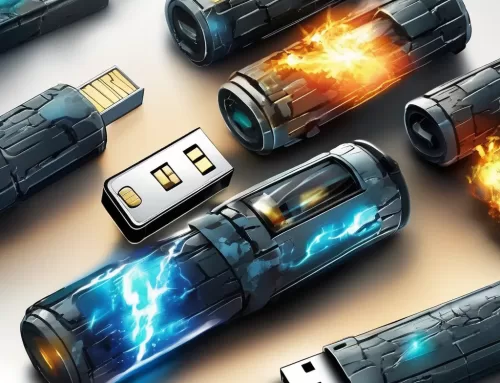In today’s digital age, data security has never been more paramount. With the growth of remote work, online transactions, and cloud computing, sensitive information is constantly being transferred and stored electronically. This presents a challenge for individuals and organizations alike, as cybercriminals are always on the lookout for vulnerabilities to exploit.
One of the most common ways that cybercriminals gain access to sensitive information is through the use of USB flash drives. While these devices are convenient for storing and transferring data, they also pose a significant security risk. Let’s explore why USB flash drives have become a prime target for cybercriminals and what steps you can take to protect your data.
The Risks of Using USB Flash Drives
Because USB flash drives are small and portable, they can be easily lost or stolen. Unfortunately, that’s not the only risk, as one of the most common ways that cybercriminals exploit USB flash drives is by infecting them with malware and then leaving the devices in public places or sending them to specific targets. When an individual inserts the infected USB flash drive into their computer, the malware can spread throughout the network, compromising sensitive data and systems.
This tactic, which is called a USB drop attack, allows hackers to gain access to sensitive information, install ransomware or other malicious programs, and even control an entire system.
Real-Life Examples
- The Tiffany’s USB Cyber Incident: In 2017, a compromised USB flash drive from the jewelry retailer, Tiffany & Co., was used to infect computers at some of their stores. The cybercriminals behind the attack leveraged various malicious payloads and tactics, including malware and backdoors, to gain access to businesses’ systems via the infected USB device. Reports indicate that these hackers were able to steal credit card info from customers who had bought items online or in-store.
- Olympic Destroyer Attack: The Olympic Destroyer attack occurred during the 2018 Winter Olympics in Pyeongchang, South Korea. The hackers behind the attack used a sophisticated form of malicious code embedded in fake Microsoft Word documents sent via USB flash drives to target Olympic organizations. The malware was designed to disrupt and disable devices, networks, and services during the Games by deleting files and blocking access to systems. According to reports, the cybercriminals had planned the attack for months before its execution.
- Lazarus Group Attack on South Korean Financial Institutions: In 2016, the so-called “Lazarus Group” (also known as the Guardians of Peace) launched an attack on several South Korean financial institutions. The attack employed a combination of spearphishing emails, malicious documents, and USB flash drives to compromise victims’ computers. Once inside their systems, the attackers proceeded to steal personal data and delete files. Additionally, Lazarus also planted malware which allowed them to access important documents stored in the targeted computers and servers.
- Ukraine Espionage Campaign: In 2019, attackers conducted an espionage campaign targeting victims in Ukraine through the use of malicious USB devices. The USB drives were physically delivered to the victims and contained malware that would install itself on their computers once plugged in. Once the hackers had access to the victim’s system, they would steal information such as logins and passwords to gain further access to other systems or networks.
Malware Isn’t the Only Risk
Another risk associated with USB flash drives is the possibility of them being intercepted during transit. USB flash drives are often used to transfer large files, and if the data isn’t encrypted, it can be accessed by cybercriminals. This is especially concerning for organizations that deal with sensitive information daily, such as financial institutions or healthcare providers.
For instance, in 2017, the U.S. Navy suffered a major data breach when an unencrypted USB drive was stolen, compromising the personal information of more than 130,000 sailors. Similarly, in 2022, a major unencrypted USB flash drive data breach resulted in the loss of personal details of every resident of the city of Amagasaki, northwest of Osaka, Japan.
5 Steps You Can Take to Protect Your Data
Despite the risks associated with USB flash drives, they continue to be a popular way to store and transfer data. Here are some steps you can take to protect your data when using these devices:
- Use encryption: Encrypting your data will make it more difficult for cybercriminals to access it. Ensure that sensitive data is encrypted before transferring it to a USB flash drive.
- Install antivirus software: Antivirus software can help protect your computer from malware infections that can be spread through USB flash drives.
- Be cautious when using USB flash drives from unknown sources: Avoid using USB flash drives that you find in public places or that come from unknown sources. Only use USB flash drives from trusted sources.
- Physically secure USB flash drives: Keep your USB flash drives in a secure location when not in use. Consider using a password-protected USB flash drive for added security.
- Regularly back up your data: In case your USB flash drive is lost, stolen, or infected, regularly back up your data to ensure that you don’t lose your important files.
An Extra Step for Extra Protection
While the above tips are helpful, the best way to protect yourself and your organization from the threat of USB flash drives is to make sure they cannot be connected to your computers or network. How? By locking your computer and network ports with Smart Keeper port locks.
Smart Keeper port locks are an important layer of security to protect organizations from malware and data theft. Port locks are physical devices that block unauthorized access to peripheral ports, such as USB ports, HDMI ports, printer ports, network ports, and more. They control who has access to these ports, providing a fence for defense against malicious threats such as malware or data theft.
Smart Keeper port locks can be programmed to ensure that only authorized personnel with the requisite credentials can gain entry. This additional physical layer of security helps businesses remain secure by protecting vulnerable ports from unauthorized access and misuse, reducing the threat that cybercriminals can attack your company with a USB flash drive.










